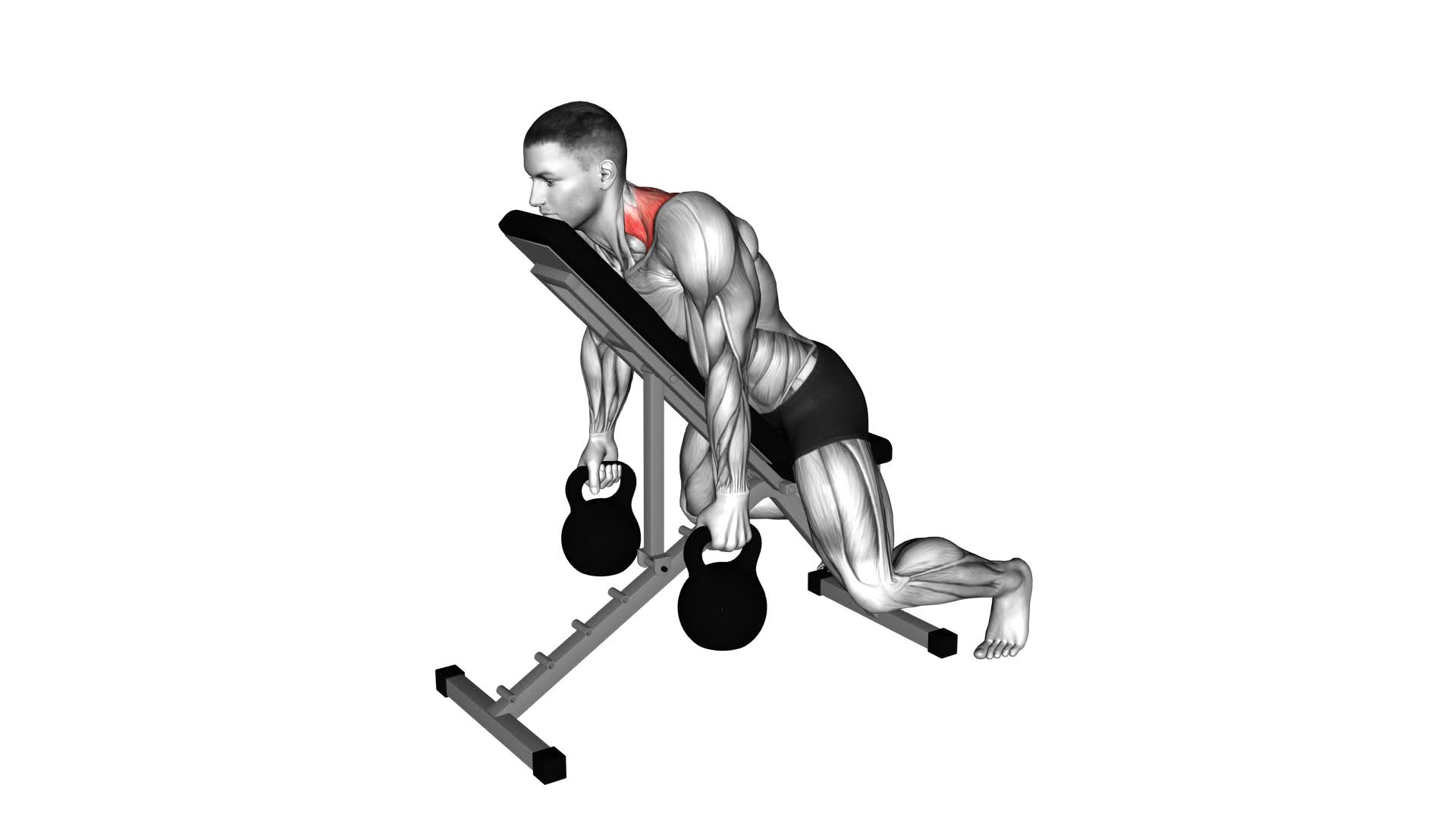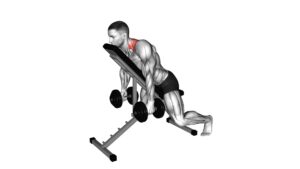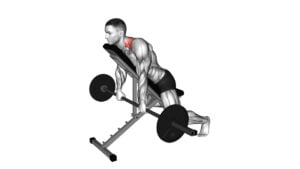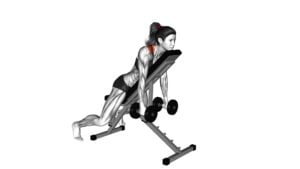Kettlebell Decline Shrug – Video Exercise Guide & Tips

Are you looking for a challenging exercise to target your traps and shoulders? Look no further than the kettlebell decline shrug!
Watch This Exercise Video
In this video exercise guide, we'll show you step-by-step how to perform this move with proper form and technique.
Plus, we'll provide variations and modifications to suit your fitness level.
Avoid common mistakes and get the most out of your workout with these helpful tips.
Get ready to elevate your strength training game with the kettlebell decline shrug!
Key Takeaways
- Kettlebell Decline Shrug targets upper back and shoulder muscles
- Proper form and gear are essential for a safe and effective workout
- Common mistakes include using too heavy of a weight and shrugging shoulders excessively
- Diversifying your kettlebell workout routine and maximizing gains can help prevent plateaus and target intended muscles effectively
Benefits of the Kettlebell Decline Shrug
You will experience significant improvements in your upper back and shoulder strength by incorporating the kettlebell decline shrug into your workout routine. The benefits of this exercise are numerous.
Firstly, the kettlebell decline shrug specifically targets the muscles in your upper back and shoulders, helping to strengthen and tone them. This exercise also helps to improve your posture by strengthening the muscles that support your spine. Additionally, the kettlebell decline shrug engages your core muscles as you stabilize your body during the movement, providing an added bonus of core strength development.
The technique for performing the kettlebell decline shrug is straightforward. Start by lying on a decline bench with your feet secured at the top and your head slightly below the bench. Hold the kettlebells in each hand, with your arms fully extended and palms facing your body.
From this starting position, shrug your shoulders up towards your ears while keeping your arms straight. Squeeze your shoulder blades together at the top of the movement, then slowly lower the kettlebells back down to the starting position. It's important to maintain proper form and control throughout the exercise to maximize its benefits and prevent injury.
Incorporating the kettlebell decline shrug into your workout routine will provide significant benefits to your upper back and shoulder strength. By following the correct technique and performing the exercise regularly, you can expect to see improvements in these areas, as well as an enhancement in your overall posture and core strength.
Equipment Needed for the Exercise
To perform the kettlebell decline shrug, you'll need some essential equipment.
Firstly, you'll need a kettlebell of an appropriate weight for your fitness level.
Additionally, it's important to have a decline bench or an adjustable bench that can be set on a decline position.
Lastly, make sure you have a comfortable and supportive pair of shoes to ensure stability during the exercise.
Essential Equipment for Exercise
To properly perform the Kettlebell Decline Shrug exercise, it's essential to have the necessary equipment. Here is a list of the essential equipment you'll need:
- Workout attire:
Comfortable and breathable clothing that allows for ease of movement is ideal for this exercise. Choose clothing that isn't too tight or restrictive.
- Exercise accessories:
Kettlebell: This exercise requires a kettlebell, which is a weighted ball with a handle. Choose a kettlebell that's appropriate for your fitness level and ensures proper form and safety.
Decline bench: A decline bench is needed to perform the exercise correctly. It allows for a greater range of motion and targets the muscles in your shoulders and upper back effectively.
Make sure you have these essential items before attempting the Kettlebell Decline Shrug exercise to ensure a safe and effective workout.
Proper Gear for Exercise
To properly perform the Kettlebell Decline Shrug exercise, you'll need specific gear and equipment.
When it comes to exercise apparel, it's important to wear comfortable and breathable clothing that allows for a full range of motion. Look for moisture-wicking fabrics that will keep you cool and dry during your workout.
For this exercise, it's recommended to wear athletic shoes with good stability and support to protect your feet and ankles.
In terms of workout accessories, you'll need a kettlebell. Choose a weight that challenges you but still allows you to maintain proper form.
Additionally, a decline bench is necessary for this exercise to ensure proper positioning and stability.
Required Workout Tools
You will need two workout tools for the Kettlebell Decline Shrug exercise: a kettlebell and a decline bench. These workout equipment are essential for performing the exercise correctly and effectively. Here's a breakdown of each item:
- Kettlebell: This fitness gear resembles a cannonball with a handle. It comes in various weights, so choose one that suits your strength and fitness level. The kettlebell will provide the resistance needed to target your traps and upper back during the exercise.
- Decline Bench: This workout equipment is an adjustable bench that can be inclined at a decline angle. It's used to support your upper body during the exercise. The decline bench allows for a greater range of motion and engages different muscle groups, enhancing the effectiveness of the Kettlebell Decline Shrug.
Proper Form and Technique
Maintain a strong and stable posture throughout the Kettlebell Decline Shrug exercise. This is crucial for performing the exercise correctly and reducing the risk of injury. One common mistake is hunching the shoulders or rounding the back, which puts unnecessary strain on the spine. To avoid this, keep your chest lifted and your shoulder blades pulled back and down throughout the movement.
Another common mistake is using too heavy of a kettlebell, which can compromise your form and increase the risk of injury. Start with a lighter weight and gradually increase as you become more comfortable and confident with the exercise. It's important to maintain control and proper technique throughout the entire range of motion.
To ensure success with the Kettlebell Decline Shrug, focus on engaging your core muscles to stabilize your body. This will help you maintain balance and control throughout the exercise. Additionally, keep your head aligned with your spine and avoid tilting it forward or backward.
Remember to breathe evenly and continuously throughout the exercise. Exhale as you lift the kettlebell and inhale as you lower it back down. This will help you maintain proper form and technique.
Variations and Modifications
One variation to consider for the Kettlebell Decline Shrug exercise is incorporating a single-arm movement. This variation adds an extra challenge to the exercise and targets different muscles.
Here are some different techniques and alternative exercises you can try to modify the Kettlebell Decline Shrug:
- Single-arm Kettlebell Decline Shrug: Instead of using both arms to perform the exercise, hold the kettlebell with one hand and perform the shrug motion. This will engage the muscles on one side of your body more intensely and help improve muscular imbalances.
- Dumbbell Decline Shrug: If you don't have access to a kettlebell, you can use dumbbells instead. Hold a dumbbell in each hand and perform the shrug motion while on the decline bench. This variation works the same muscles as the Kettlebell Decline Shrug but with a different grip and weight distribution.
- Resistance Band Decline Shrug: To add variety to your workout, you can use a resistance band instead of a kettlebell or dumbbells. Attach the band to a stable object and hold the handles while performing the shrug motion. This modification adds a different type of resistance and challenges your muscles in a unique way.
Common Mistakes to Avoid
To ensure proper form and maximize the effectiveness of the Kettlebell Decline Shrug exercise, it's crucial to avoid these common mistakes. Proper technique is essential to prevent injury and achieve optimal results.
One common mistake is using too heavy of a weight. It's important to start with a manageable weight and gradually increase as your strength improves. Using a weight that's too heavy can compromise your form and increase the risk of injury.
Another mistake is shrugging your shoulders excessively. The movement should primarily come from your traps and upper back, not your shoulders. Avoid lifting your shoulders towards your ears and focus on engaging your traps to lift the kettlebell.
Additionally, it's important to maintain a neutral spine throughout the exercise. Avoid rounding or arching your back, as this can strain your spine and lead to discomfort.
Lastly, rushing through the exercise is another common mistake. Take your time and perform each repetition with control and focus. Remember to breathe properly and maintain proper form throughout the entire exercise.
Tips for Maximizing Your Results
To maximize your results, incorporate a variety of kettlebell exercises into your routine. By diversifying your workouts, you can target different muscle groups and prevent plateaus.
Here are some effective techniques for maximizing gains with kettlebells:
- Mix up your exercises: Instead of sticking to the same routine, try incorporating exercises like kettlebell swings, snatches, and Turkish get-ups. These movements engage multiple muscle groups and challenge your body in different ways.
- Focus on form: Proper form is crucial for maximizing your results and preventing injuries. Before increasing the weight or intensity, make sure you have mastered the correct technique for each exercise. This will ensure that you're effectively targeting the intended muscles and minimizing the risk of strain.
- Gradually increase weight and intensity: To continue making progress, gradually increase the weight of your kettlebells and the intensity of your workouts. This progressive overload stimulates muscle growth and strength gains over time.
- Incorporate high-intensity interval training (HIIT): HIIT workouts with kettlebells can be very effective for maximizing gains. Alternating between periods of intense exercise and short rest periods boosts your metabolism, increases calorie burn, and improves cardiovascular fitness.
- Listen to your body: Pay attention to how your body feels during and after each workout. If you experience pain or discomfort, adjust your technique or modify the exercise. It's important to prioritize safety and avoid overtraining.
Frequently Asked Questions
How Many Repetitions Should I Do for the Kettlebell Decline Shrug Exercise?
For the kettlebell decline shrug exercise, the optimal rep range depends on your fitness level and goals.
Start with a weight that challenges you but allows for proper form. Aim for 8-12 repetitions per set to build strength and muscle.
As you progress, increase the weight gradually and decrease the number of repetitions to 6-8 for more intensity.
Remember to always focus on proper technique and listen to your body to avoid injury.
Is the Kettlebell Decline Shrug Suitable for Beginners?
The kettlebell decline shrug can be a suitable exercise for beginners. It allows you to modify the intensity by choosing an appropriate weight and adjusting the incline of the bench.
This exercise targets your traps and upper back muscles, helping to improve your posture and shoulder stability.
Incorporating the kettlebell decline shrug into your workout routine can also enhance your grip strength and overall upper body strength.
It's important to start with lighter weights and gradually increase as you build strength and confidence.
Can I Perform the Kettlebell Decline Shrug Exercise Without a Decline Bench?
Yes, you can perform the kettlebell decline shrug exercise without a decline bench. If you don't have access to a decline bench, there are alternative exercises you can do to work the same muscle groups.
However, it's important to note that using a decline bench offers unique benefits such as increased range of motion and targeting specific muscles in your back and shoulders. So, if possible, using a decline bench would be recommended for optimal results.
Should I Use a Specific Weight for the Kettlebell in This Exercise?
When performing the kettlebell decline shrug exercise, it's important to consider the specific weight you use. The weight should challenge you, but not be too heavy that it compromises your form. You can start with a lighter weight and gradually increase as you get stronger.
Additionally, if you don't have a decline bench, you can modify the exercise by using a stability ball or an elevated surface to create the decline position.
Are There Any Specific Warm-Up Exercises Recommended Before Performing the Kettlebell Decline Shrug?
Before performing the kettlebell decline shrug, it's important to warm up your muscles properly.
Dynamic stretches are a great way to prepare your body for this exercise. They help increase blood flow, improve flexibility, and prevent injury.
Some examples of dynamic stretches you can do include arm circles, leg swings, and trunk rotations.
Incorporating these warm-up exercises into your routine will ensure that your muscles are ready for the kettlebell decline shrug and help you get the most out of your workout.
Conclusion
In conclusion, the kettlebell decline shrug is a highly effective exercise for strengthening the upper back and shoulders. By properly performing this exercise with the right form and technique, you can maximize your results and avoid common mistakes.
Remember to start with an appropriate weight and gradually increase it as you progress. With the proper equipment and variations, you can customize the exercise to suit your fitness level and goals.
Incorporate the kettlebell decline shrug into your routine for a stronger and more defined upper body.

Author
Years ago, the spark of my life’s passion ignited in my mind the moment I stepped into the local gym for the first time. The inaugural bead of perspiration, the initial endeavor, the very first surge of endorphins, and a sense of pride that washed over me post-workout marked the beginning of my deep-seated interest in strength sports, fitness, and sports nutrition. This very curiosity blossomed rapidly into a profound fascination, propelling me to earn a Master’s degree in Physical Education from the Academy of Physical Education in Krakow, followed by a Sports Manager diploma from the Jagiellonian University. My journey of growth led me to gain more specialized qualifications, such as being a certified personal trainer with a focus on sports dietetics, a lifeguard, and an instructor for wellness and corrective gymnastics. Theoretical knowledge paired seamlessly with practical experience, reinforcing my belief that the transformation of individuals under my guidance was also a reflection of my personal growth. This belief holds true even today. Each day, I strive to push the boundaries and explore new realms. These realms gently elevate me to greater heights. The unique combination of passion for my field and the continuous quest for growth fuels my drive to break new ground.







